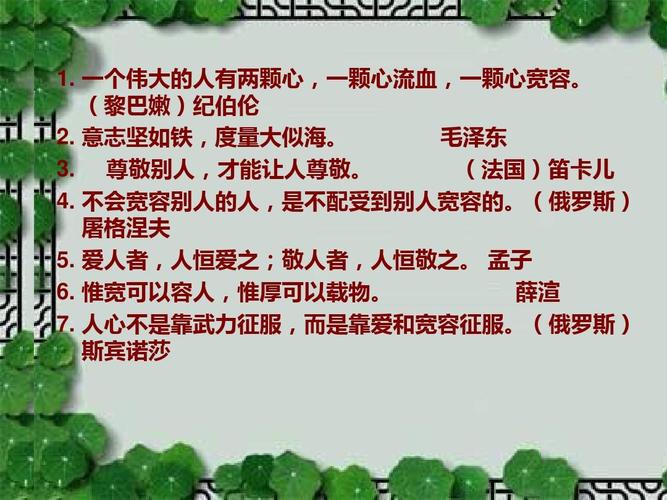
英语中地点和目的的修饰词
表示地点和目的的副词统称为地点副词。
常见的这类副词有:
表示地点的:here, there, home, upstairs, downstairs, anywhere,
everywhere, nowhere, somewhere, abroad, elwhere等。
表示位置关系的:above, below, down, up, out, in, across, back,
along, over, round, around, away, near, off, on, inside, outside, past等。
在表示位置关系的副词中,有些副词也可用作介词(如:above, over,
beyond, around, below, down, up, in, along, near, off, on, past等),在没有
宾语时就是副词,有宾语时就是介词,如:
Come in, plea. (副词)
They live in the next room. (介词)
Let's take along. (副词)
Let's walk along this street. (介词)
She looked around. (副词)
They sat around the table. (介词)
Let's go on with (副词)
What subject will you speak on? (介词)
地点副词在句中的位置
地点副词常放在动词后面,如果是及物动词,一般就放在宾语后面。
如:I remember having en him somewhere.
Wuxia films are popular in China.
地点副词和时间副词并列使用时,一般要把地点副词放在时间副词之前。
如:
We had a meeting here yesterday.
He did the work carefully here yesterday.
如果地点状语很长时,也可以放在时间状语之后。如:
He was born in 1940 in a small village at the foot of Mount Tai.
地点副词常可以用作表语
副词可以用作表语,主要是地点副词,时间副词和其他副词有时也可以用
作表语。
如:
They are inside. 他们在里面。
How long will she be away? 她要离开多久?
When will you be back? 你什么时候回来?
You haven't been around much. 你很少到这边来。
He'll be round in an hour. 他一个小时内就到。
Now autumn is in. 秋天来了。
I must be off now. 我得走了。
We are behind in our plan. 我们落在计划后面了。
1) 作状语修饰动词、形容词、其他副词、介词短语及全句。其位置如下:
①时间副词和地点副词一般放在句末,若两种副词同时出现,则地点副词
在前,时间副词在后,也可把时间副词放在句首。
He did his work here yesterday.他昨天在这里工作。
②频度副词放在实义动词之前,助动词、情态动词及be动词之后。
You must always wait in a queue.你必须排队。
③程度副词放在所修饰的形容词之前(enough则放在后面)。如:very
careful, old enough。
④方式副词修饰不及物动词时,放在所修饰的词之后;修饰及物动词时,
放在动词之前或宾语之后。如宾语较长,也可将副词放在动词与宾语之间。
a: Father works hard.简的父亲工作努力。
b: Bill did the work very well. 比尔做工作很好。
c: He wrote carefully some letters to his friends. 他认真地给朋友们写
信。
⑤修饰介词时(well, right, just, soon等)放在介词之前;修饰全句时
(frankly, briefly, personally, luckily, generally speaking等)放在句首。
(2) 作表语。作表语的副词一般是表示地点及位置的副词。如:They are
downstairs.
(3) 作定语。作定语的副词一般是表示地点、位置的副词,还有一些表示
时间的副词,都作后置定语。如:In the streets below, there are other
problems.
(4) 作介词宾语。如:in here,from abroad,since then,until
recently,until very late等。
3. 易混淆的副词
(1) also, too, either, as well
also和too用于肯定句,either用于否定句
also放在实义动词前,be动词、助动词之后,too常置于句末。as well
与too可互换。
(2) already, yet , still
already(已经),用于肯定句;yet(已经)用于否定句或疑问句;still(还、仍
然)一般用于肯定句或疑问句中。
(3) ago, before
ago表示“现在以前”某一时刻,常用于一般过去时。before表示“过去
某一时间以前”,一般用于过去完成时;单独使用时,泛指以前,用于现在完
成时或一般过去时。
(4) fast, soon
fast表示“速度快”,soon侧重指两件事情先后发生,中间间隔的时间
短。
(5) just, just now
just “刚才”,常用于现在完成时。just now“刚才,不久以前”,常用
于一般过去时。
(6) so…that, such…that
so修饰形容词、副词;such修饰名词。另外还要注意以下两点:
名词前有表示“多”(many,much)、“少”(1ittle,few)的形容词时,
要用so。
修饰可数名词单数时,so与such可互换,但词序不同。如:such a
good student相当于so good a student。
(7) almost, nearly
在not,pretty,very后只能用nearly。
在any,never,no,none前只能用almost。
其它情况下可互换。
(8) fairly, quiet, rather
按程度强弱排列,顺序为:rather, quite, fairly。
fairly多用于褒义;rather多用于贬义形容词、too及比较级前。
quite和rather可修饰名词,置于“不定冠词+名词之前”。如:quite a
good story, rather a strong wind。
(9) much too, too much
much too修饰形容词、副词;too much修饰不可数名词,也可单独做
主语、宾语或表语。
4. 两种形式的副词在含义上的区别
clo接近地 cloly密切地,严密地
free免费地 freely无拘束地,自由地
hard努力地 hardly几乎不
most很,非常 mostly主要地
wide广阔,充分 widely广泛地
high高(具体) highly高度地,非常地
deep深(具体) deeply深深地(抽象)
loud大声地 loudly大声地(含有喧闹的意思)
near邻近 nearly几乎
late迟 lately近来
5. 某些以-ly结尾的词是形容词而不是副词。如:friendly,deadly,
likely,lively,lonely,lovely,orderly, silly,timely等。

本文发布于:2023-05-27 08:52:24,感谢您对本站的认可!
本文链接:https://www.wtabcd.cn/zhishi/a/1685148745180888.html
版权声明:本站内容均来自互联网,仅供演示用,请勿用于商业和其他非法用途。如果侵犯了您的权益请与我们联系,我们将在24小时内删除。
本文word下载地址:英语中地点和目的的修饰词.doc
本文 PDF 下载地址:英语中地点和目的的修饰词.pdf
| 留言与评论(共有 0 条评论) |